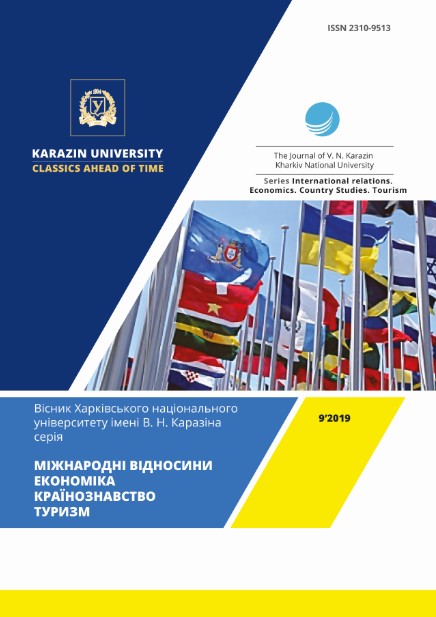Analysis of investment activity in the Baltic region
Abstract
The article studies the role of foreign capital in the Baltic countries. The subject of the study is the structure and dynamics of foreign capital in Latvia, Lithuania and Estonia. The goal is to analyze the influence of foreign capital on the economic development of the Baltic countries. The objective is to consider in more detail the flows of foreign direct investment, portfolio investment and other types of investments, to identify the main investor countries, to consider the balance of payments and to construct regression models of influence of foreign capital on the economic development of countries. General scientific methods are used: scientific abstraction, comparative, method of analysis and synthesis, systematization and generalization, method of calculation, and also a method of regression analysis. The following results are obtained: investment activity is an important component for the economies of the Baltic countries. The leader in attracted capital not only in the region, but also in the EU is Estonia, and in terms of investment abroad – is Lithuania in the Baltic region. The main areas where capital is directed are: financial sector, industrial and IT-technologies. Regression analysis shows that the outflow of capital from the Baltic countries abroad positively affects the development of their economies. Conclusions: the balance of payments regulation for Latvia should take place only by increasing the "credit" part of the current account, and for Lithuania – by increasing both the current account and the investment liabilities, because there is the inverse dependence of GDP on investment income, which is directed to foreign investors in the model for the first country, while for Lithuania there is a direct dependence of exports on investment income abroad.
Downloads
References
Olenchenko V. (2017) Strany Baltii: Kanun 25-letiya nezavisimosti [Baltic countries: Eve of the 25th anniversary of independence]. World Economy and International Relations, vol. 4, no. 61, pp. 105-108. (in Russian)
Rodіonova Т.А. (2015) Dokhіdnіst' іnozemnikh іnvestitsіy v kraїnakh z rinkom, shcho formuєt'sya: vpliv na zovnіshnі disbalansi [Foreign investment returns in emerging market countries: impact on external imbalances] (PhD Thesis), Odesa: Odessa I.I. National University. (in Ukrainian)
Ogbokor C.A. (2016, November 2). Econometric Analysis of the Impact of Foreign Direct Investments on Economic Growth in Namibia: Evidence from Annual Data. International Journal Of Economics And Finance Studies, p. 105-108. Available at: http://www.sobiad.org/ejournals/journal_ijef/archieves/IJEFS2016_2/paper62B_Ogbokor.pdf.
Baum С.Е., Pundit, M. & Ramayandi A. (2017). Capital Flows and Financial Stability in Emerging Economies. ADB Economics Working Paper Series. Available at: https://www.adb.org/sites/default/files/publication/372256/ewp-522.pdf.
Igan D., Kulan A.M. & Marzaei A. (2016). Real Effects of Capital Inflows in Emerging. IMF Working Paper. Available at: https://www.imf.org/external/pubs/ft/wp/2016/wp16235.pdf.
PWC. (2017). Doing business and investing in Estonia. Available at: https://www.pwc.com/ee/et/publications/DoingBusinessinEstonia/Doing%20Business%202017.pdf.
International Monetary Fund. (2019). Balance of Payments. Available at: http://data.imf.org/?sk=7A51304B-6426-40C0-83DD-CA473CA1FD52.
International Monetary Fund. (2019). World Economic Outlook Database. Available at: https://www.imf.org/external/pubs/ft/weo/2019/01/weodata/index.aspx.
Invest in Estonia. (n.d.). Estonian economy. Available at: https://investinestonia.com/business-in-estonia/estonian-economy/fdi/.
Investment and Development Agency of Latvia. (n.d.). Foreign Direct Investment. Investor Business Guide. Available at: http://www.liaa.gov.lv/en/invest-latvia/investor-business-guide/foreign-direct-investment.
Authors who publish with this journal agree to the following terms:
- Authors retain copyright and grant the journal right of first publication of this work under the terms of a license Creative Commons Attribution License 4.0 International (CC BY 4.0).
- Authors are able to enter into separate, additional contractual arrangements for the non-exclusive distribution of the journal's published version of the work (e.g., post it to an institutional repository or publish it in a book), with an acknowledgement of its initial publication in this journal.
- Authors are permitted and encouraged to post their work online (e.g., in institutional repositories or on their website) prior to and during the submission process, as it can lead to productive exchanges, as well as earlier and greater citation of published work.




